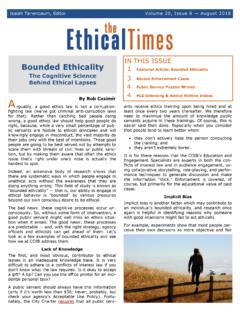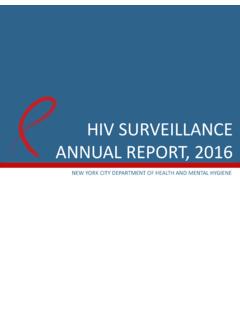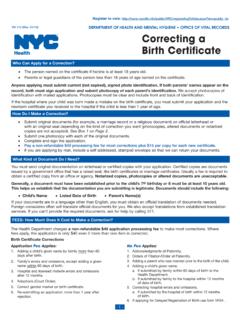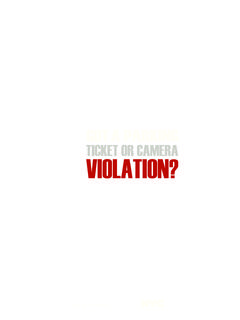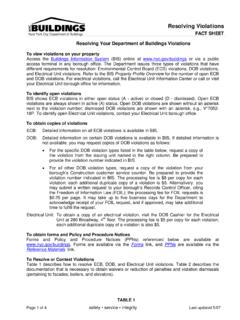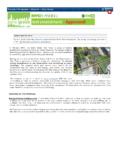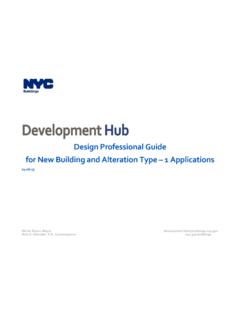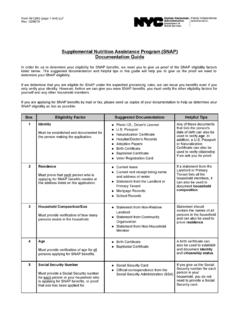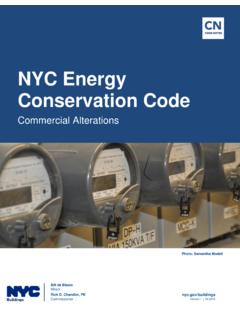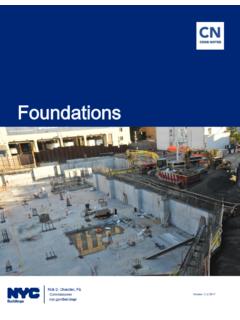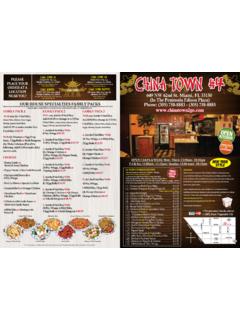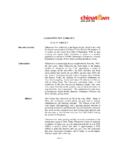Transcription of CHINA TOWN BUS STUDY - Welcome to NYC.gov
1 chinatown BUS STUDY New York City Department of City PlanningTransporta on DivisionOctober2009 chinatown Bus StudyFinal ReportOctober 2009 Michael R. Bloomberg, MayorCity of New YorkAmanda M. Burden, FAICP, DirectorNew York City Department of City PlanningThis STUDY was funded by a matching grant from the Federal Highway Administra on, under NY-SDOT Pin , FHWA under the Subreagional Transporta on Planning Program, year 2008/2009. This document is disseminated under the sponsorship of the Department of Transporta on in the interest of informa on exchange. The contents of this report reflect the views of the au-thor, who is responsible for the facts and the accuracy of the data presented herein.
2 The contents do not necessarily reflect the views or policies of the Federal Highway Administra on, nor of the New York Metropolitan Transporta on Council. This report does not cons tute a standard, speci-fica on or regula on. Table of ContentsExecu ve Summary 1 Introduc on 2 History 3 STUDY Area 4 Land Use 5 Zoning 7 Bus Opera ons 9 Business Model 13 Previous A empts to Improve Condi ons 13 Industry Regula ons 15 Issues and Community Concerns 17 Conges on 17 Pollu on and Li er 18 Safety 19 Community Concerns 20 Case Studies 21 Boston, MA 22 Washington, DC 24 Philadelphia 28 Port Authority Bus Terminal and George Washington Bridge Bus Sta on 31 Recommenda ons and Next Steps 33 Long Term 33 Near Term 33 Conclusion 35 Appendix A: Demographics 37 Appendix B.
3 Transporta on Network 45 Public Transporta on 47 Truck Routes 49 Parking 50 Street Network 51 Appendix C : Accidents 55 Bibliography 63 Credits 651 BUS STUDY CHINATOWNE xecu ve SummaryThe chinatown private interstate bus industry began opera ng from chinatown in 1997, primarily serving restaurant workers and other Chinese immigrants residing in New York City. The buses provide an alterna ve to air travel, which is costly and not always possible for those who do not have resident status. A er September 11, 2001 airline travel became more me-consuming and cumbersome and bus travel became popular among students and bargain seekers outside the im-migrant market.
4 Another reason for the popularity of chinatown buses is that they cost less than other long-standing commercial bus companies, such as Greyhound or Peter Pan. chinatown buses are also more convenient for the target popula on since they operate from the chinatown of the origin city to the chinatown of the des na on city, and eliminate unnecessary chinatown Bus industry has grown exponen ally since 1997, and the buses now travel to many states along the east coast such as Massachuse s, District of Columbia, Delaware, Mary-land, Virginia, Pennsylvania and Georgia. Some bus companies travel further west to Ohio, Ten-nessee and Illinois.
5 Many problems have arisen as a result of this expansion and compe on. A significant strain has been placed on the surrounding community. Reported and observed prob-lems include increased conges on, noise, pollu on, li er and decreased safety and security for pedestrians, passengers and neighborhood STUDY documents the efforts of New York City to improve these condi ons. Case studies and historical models are presented to demonstrate how other ci es manage the chinatown bus in-dustry and how New York City has historically managed similar problems of severe conges on. There are several studies underway in chinatown that overlap the STUDY area of this analysis.
6 The Canal Area Transporta on STUDY (CATS) is being conducted by the New York Metropolitan Trans-porta on Council (NYMTC). Although CATS does not directly address the problems associated with interstate buses, the STUDY does examine conges on issues in the chinatown area. Lower Manha an Street Management is a STUDY being undertaken by the New York City Department of Transporta on (NYCDOT) that examines placard parking, as well as bus and curbside man-agement. NYCDOT is also working with Congresswoman Nydia Velazquez s office, the Chinese Consolidated Benevolent Associa on (CCBA) and the Asian American Federa on of New York (AAFNY) to commence a parking and access STUDY for chinatown .
7 Following a detailed examina on of the bus opera ons, this report recommends that the City ins tute a permi ng process to require bus operators to pay for curbside use, just as commercial trucks are required to pay for parking. It is important to note however, that in New York State ins tu ng a permi ng system requires state legisla on. Ins tu ng a permit process will control the growth of the industry and its associated impacts by assigning the space from which buses may operate, and specifying hours when they are permit-ted to operate. Addi onally, a permit process would add a measure of safety to the industry by discouraging bus companies from changing their names to evade safety regula ons.
8 Lastly, con-ges on would be eased by assigning the curb space properly and elimina ng the need to double park, and block New York City Transit bus stops and parking meters. Noise and pollu on would be reduced by elimina ng the need for buses to circle while looking for parking. These recom-menda ons would benefit the chinatown community in many ways. Un l a lower Manha an bus terminal can be built, a permi ng system would provide order to the industry. 2 chinatown BUS STUDYI ntroduc on The chinatown Bus STUDY examines the opera ons of the private interstate bus companies that load and discharge passengers throughout chinatown (for loca ons see Figure 1). Recommen-da ons to improve those opera ons are offered, which may help alleviate the conges on these buses create, to improve traffic circula on in the area and help travelers find buses more easily.
9 Figure 2 illustrates the STUDY area in context of the borough, and demonstrates its proximity to the Port Authority Bus Terminal and the George Washington Bridge Bus Sta 1 This STUDY provides a comprehensive analysis of exis ng condi ons, including informa on about the STUDY area s land use, zoning, demographics, street network, accidents and availability of public transporta on. In addi on, the opera onal characteris cs of the companies conduc ng business from chinatown have been documented, including their frequency, des na ons and business model. Lastly, traffic circula on and conges on problems have been iden fied and rec-ommenda ons have been developed to improve condi ons.
10 MANHATTAN BRCHERRY STPEARL STST JAMES PLCLIFF STROSE ST1999 CT BNDYPARK ROW2000 CB BNDYGOLD STCATHERINE STUNNAMED STBEEKMAN STBEEKMAN STSPRUCE STBROOKLYN BRDOVER STJOHN STFULTON STBKBR APPR2000 CB BNDYCHAMBERS STREADE STDUANE STTHOMAS STWORTH STLEONARD STWHITE STWALKER STLISPENARD STHOWARD STCHURCH STAV OF THE AMERICSVARICK STMERCER STANN STPLATT STALLEYPIKE STMN BR APPRMARKET STOLIVER STPIKE SLWATER STWATER STFRONT STSOUTH STFDR DR NB EN BK BRFDR DRFDR DRMONROE STMADISON STHENRY STE BROADWAYE RIVER SHL WDIVISION STMOSCO STHOGAN PLBAYARD STKENMARE STDELANCEY STRIVINGTON STSTATON STHESTER STPELL STGRAND STCT BNDYJEFFERSON STMONTGOMERY STALLEYBROOME STSPRING STBROOME STMOTT STMULBERRY STBAXTER STCENTRE STLAFAYETTEBROADWAYCROSBY STCENTERMARKET PLELIZABETH STBOWERYCHRYSTIE STFORSYTH STALLEN STLUDLOW STORCHARD STESSEX STNORFOLK STSUFFOLK STCLINTON STATTORNEY STRIDGE SPITT STMERCER STArrival/Departure LocationsStudy AreaArrival and DepartureLocations 88 East Broadway133 East Broadway59 Canal Street33 Allen Street13 Allen Street175B Lafayette Street139 Canal Street69 Chrystie Street87 Chrystie Street122 Allen Street3 BUS STUDY CHINATOWNH istoryThe chinatown Buses, also known as Dragon Buses in the Chinese community.
